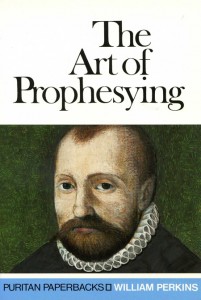The Art of Prophesying with The Calling of the Ministry.
William Perkins, edited with an introduction by Sinclair Ferguson. Originally published 1596, Banner of Truth edition 1996, 191 pp.
Preaching was central to the lives and ministries of the Puritans, and it is reckoned that 90% of Puritan literature takes the form of sermons. This little manual was written by one of the earliest and greatest of Puritan preachers: William Perkins (1558-1602), of Great St Andrew’s, Cambridge, who exercised a huge influence on the rising generation of young preachers in the late Elizabethan period, such that he is usually regarded as the father of the English Puritan movement.
The book is therefore important, a manifesto setting out the importance and centrality of preaching for the benefit of the whole rising Puritan movement. As those who seek to follow in the footsteps of the Puritans, we would do well to benefit from the same teaching on preaching as they received.
The book commences by stressing the ‘prophetic’ nature of the minister’s work, in two areas: preaching and public prayer. Perkins begins his discussion of preaching by an extended and very elementary discussion of the canon of Scripture, which will be unlikely to be of much use today.
Much more valuable, however, is the succeeding chapter on the interpretation of Scripture, which directly challenges the Roman Catholic view of the fourfold sense of Scripture. Perkins argues for a single literal interpretation of Scripture, aided by the analogy of faith, the circumstances of the passage and comparison with other passages. By the ‘analogy of faith’, Perkins means the consistent teaching of the rest of Scripture. He proposes that where a passage appears to diverge from this analogy, then another interpretation, consistent both with the passage and with the analogy must be found. This is clear and helpful, as is the example, of the correct interpretation of 1 Corinthians 11:24 in opposition to the transubstantiation taught by Romanists from this passage (pp.31-32). This whole method amounts, of course, to nothing more or less than the interpretation of Scripture by Scripture.
Perkins goes on to discuss the figures of speech used in Scripture, and the way to ‘resolve’ doctrines – particular points of teaching to be stressed in the sermon – from the passage. Regarding application, Perkins encourages thought on the different categories of hearers who will be present, with a challenge or encouragement for each of them in the application of the sermon. This remains sound and useful counsel. Furthermore, his clear distinction between ‘Law ‘ and ‘Gospel’, and stress on the need for preaching to stress the former first, to prepare hearers to receive the message of salvation in Christ, is helpful, and was likely very influential on Puritan thought regarding evangelism. However, one possible weakness of his approach is a tendency to merge doctrinal instruction into application (c.f. pp.66-67), which may result in the necessary practical challenge being limited or obscured. In this area, the clear distinction of a later generation of homiletical teachers, that the doctrine must be taught, illustrated, and then applied, is probably more helpful.
In discussing preaching itself, Perkins stresses the vital need for the minister’s public and private life to be consistent with his teaching (p.73), adding this striking illustration:
[Preachers must have] an inward sense of the doctrine we are to preach. Wood that is capable of burning is not set alight unless fire is put to it. Similarly, anyone who would encourage godly affections in others must first have godly affections himself. Thus, whatever responses a particular sermon requires should first be stirred up in our own minds, so that we can kindle the same fire in our hearers. (p.74)
As preachers, this certainly must be the goal!
By contrast, Perkins’ handling of public prayer is exceedingly scanty – almost an afterthought (pp.77-78).
Along with The Art of Prophesying is printed another short work by Perkins, The Calling of the Ministry. This work consists of an extended exposition of two passages, Job 33:23-24, and Isaiah 6:5-9. It describes the high calling of the Gospel ministry, and the urgent need of men for such a work, in a warm and compelling manner. This section of the book (pp.83-191) would be very useful for any man wrestling with the possibility of a call to the ministry.
This edition is an updated version of these texts, prepared by Sinclair Ferguson. The updating has been done with skill and sensitivity, so that the text is fresh and clear, yet without jarringly modern phrases. The Scripture quotations are from the NKJV.



Leave a Reply